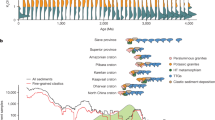Abstract
The dolomites (Ca Mg (CO3)2) of the Lower Magnesian Limestone (or Cadeby Formation, Upper Permian age) are believed to have been formed by evaporation of seawater and include sulphate also associated with that environment. Mineralization in the formation includes baryte (BaSO4) and galena (PbS) together with other sulphides and has been ascribed to many different modes of origin. Sulphur isotope analyses have now shown that the sulphates were derived from seawater of Upper Permian age and that sulphides in sites of former anhydrite (CaSO4) nodules were formed by bacterial reduction of sulphate. This latter point is confirmed by the carbon isotope composition of the carbonates whose oxygen isotope values indicate the possibility of admixture of meteoric water to the system. Other baryte mineralization directly involves Upper Permian seawater or evaporite sulphate, whereas smaller baryte occurrences and epigenetic galena mineralization show no such direct involvement.
This is a preview of subscription content, access via your institution
Access options
Subscribe to this journal
Receive 51 print issues and online access
$199.00 per year
only $3.90 per issue
Buy this article
- Purchase on Springer Link
- Instant access to full article PDF
Prices may be subject to local taxes which are calculated during checkout
Similar content being viewed by others
References
Harwood, G. M. & Smith, F. W. Proc. EZ 82 Conf. Spec. Vol. geol. Soc. Lond. (in the press).
Harwood, G. M. Contr. Sedim. 9, 61–72 (1980).
Deans, T. Miner. Mag. 32, 705–715 (1961).
Harwood, G. M. thesis, Open Univ. (1981).
McCrea, J. M. J. Chem. Phys. 18, 849–857 (1950).
Craig, H. Geochim. cosmochim. Acta 12, 133–149 (1957).
Deines, P. Int. J. Mass Spectrom. Ion Phys. 4, 283–295 (1970).
Sharma, T. & Clayton, R. N. Geochim. cosmochim. Acta 29, 1347–1353 (1965).
Robinson, B. W. & Kusakabe, M. Analyt. Chem. 47, 1179–1181 (1975).
Coleman, M. L. & Moore, M. P. Analyt. Chem. 50, 1594–1595 (1979).
Claypool, G. E., Holser, W. T., Kaplan, I. R., Sakai, H. & Zak, I. Chem. Geol. 28, 199–260 (1980).
Harwood, G. M. Proc. EZ82 Conf. Spec. Vol. geol. Soc. Lond. (in the press).
Rye, R. O. & Ohmoto, H. Econ. Geol 69, 826–842 (1974).
Dhannoun, H. Y. & Fyfe, W. S. Prog. Expl. Petrol., N.E.R.C. Publ. Ser. D. 69–71 (1972).
Orr, W. L. Bull. Am. Ass. petrol. Geol. 50, 2295–2318 (1974).
Emrich, K., Erhalt, D. H. & Vogel, J. C. Earth planet. Sci. Lett. 8, 363–371 (1970).
Hudson, J. D. J. geol. Soc. Lond. 133, 637–660 (1977).
Craig, H. in Stable Isotopes in Oceanographic Studies and Palaeotemperatures (ed. Tongiorgi, E.) 3–24 (Consiglio Nazionale delle Ricerche, Pisa, 1965).
Fritz, P. & Smith, D. G. W. Geochim. cosmochim. Acta 34, 1161–1173 (1970).
Coleman, M. L. J. geol. Soc. Lond. 133, 593–608 (1977).
Author information
Authors and Affiliations
Rights and permissions
About this article
Cite this article
Harwood, G., Coleman, M. Isotopic evidence for UK Upper Permian mineralization by bacterial reduction of evaporites. Nature 301, 597–599 (1983). https://doi.org/10.1038/301597a0
Received:
Accepted:
Issue Date:
DOI: https://doi.org/10.1038/301597a0
This article is cited by
-
Prediction of contaminant transport in fractured carbonate aquifer types: a case study of the Permian Magnesian Limestone Group (NE England, UK)
Environmental Science and Pollution Research (2019)
-
Sealing of fluid pathways in overpressure cells: a case study from the Buntsandstein in the Lower Saxony Basin (NW Germany)
International Journal of Earth Sciences (2005)
Comments
By submitting a comment you agree to abide by our Terms and Community Guidelines. If you find something abusive or that does not comply with our terms or guidelines please flag it as inappropriate.



